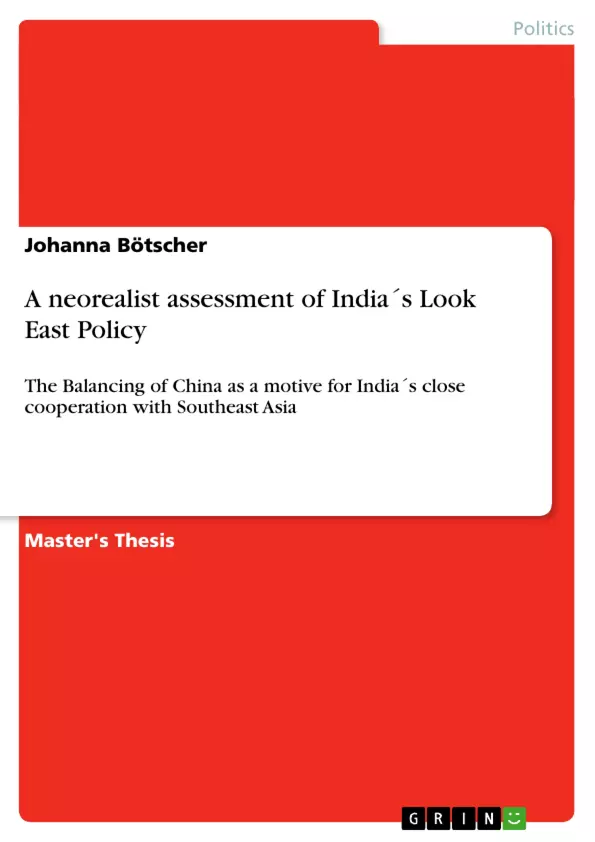In line with its new foreign policy after the end of the Cold War India started to significantly increase its political, economic and military relations with Southeast Asia at the beginning of the 1990ies. Since then, but particularly for the last ten years this so-called „Look East Policy“ has grown to a strong and multifaceted partnership that constitutes a major component of Indian foreign policy today. The principal purpose of this thesis is to evaluate India’s motives for its strong interactions with Southeast Asia. The most common approach among academics to explain India’s Look East Policy follows a liberal understanding of International Relations. Liberals argue that both, India and the Southeast Asian countries want to exploit complementarities in their economic and social structures: This thesis however, follows a neorealist understanding of International Relations by arguing that the Look East Policy is primarily a strategy of the Indian government to counterbalance the growing Chinese influence in Southeast Asia: Due to the geographic closeness of the Asia Pacific region to the Indian subcontinent, China’s presence there is particularly worrisome for India. It thus aligns with the Southeast Asian states in order to push back the Chinese power. In addition to evaluate the motives for India’s Look East Policy, the aim of this thesis is also to confute the liberal critiques on the balance of power theory and to show that the conception has still an enormous predicative power also in the twenty-first century. (Neorealist Balance of Power/Balance of Threat Theory). Moteover, while most existing publications using the balance of power theory mainly focus on balancing for political and military power this thesis also takes into account balancing for economic strength. It thus offers a broader approach by also explaining foreign economic policy. The thesis tests the neorealist balance of power theory by applying it to two case studies: On the one hand the negotiation process on the India-ASEAN Free Trade agreement in goods will be examined, on the other hand India’s cooperation with Myanmar during the last ten years will be analysed in detail.
Inhaltsverzeichnis (Table of Contents)
- Introduction
- Aims of the Thesis
- Outline
- Literature Review
- Indian Foreign Policy
- India’s Look East Policy
- Geopolitics and Foreign Economic Policy
- The Neorealist Balance of Power Theory
- Liberal Critiques of the Balance of Power Theory
- The Balance of Power Theory in the Twenty-First Century
- Methodology
- The Balance of Power Theory and the Asia-Pacific Region
- The Balance of Power Theory and India’s Look East Policy
- Case Selection
- Indian Foreign Policy – An Overview
- India’s New Positioning After the End of the Cold War
- India-China Relations
- India-Southeast Asia Relations
- Case Study I: The India-ASEAN Free Trade Agreement
- Chronological Progression
- Statements of the Main Policy-Makers Involved in the FTA Process
- The Influence of Non-State Actors
- Factual Benefits Arising from the FTA
- Case Study II: India’s Close Relations with Myanmar
- Chronological Progression
- Statements of the Main Policy-Makers Involved
- The Influence of Non-State Actors
- Factual Benefits Arising from the Cooperation
Zielsetzung und Themenschwerpunkte (Objectives and Key Themes)
This thesis aims to evaluate India’s motives for its strong interactions with Southeast Asia, arguing that the "Look East Policy" is a strategy to counterbalance growing Chinese influence in the region. It seeks to demonstrate the continuing relevance of the neorealist balance of power theory in the twenty-first century, challenging liberal critiques that emphasize economic interdependence and the declining role of nation-states. The thesis also offers a unique neorealist assessment of India's Look East Policy, examining its application within a sub-systemic state system in Asia.- India’s Look East Policy as a strategy to counterbalance China’s growing influence in Southeast Asia
- The applicability of the neorealist balance of power theory in the twenty-first century
- The relevance of the balance of power theory within a sub-systemic state system in Asia
- The role of non-state actors in shaping India's Look East Policy
- The economic and political benefits of India's engagement with Southeast Asia
Zusammenfassung der Kapitel (Chapter Summaries)
The introduction outlines the thesis’s aims, arguing that India’s "Look East Policy" is driven by a desire to counterbalance China’s growing influence in Southeast Asia. The literature review examines existing scholarship on Indian foreign policy and the Look East Policy, highlighting the dominant liberal perspective. The chapter on geopolitics and foreign economic policy delves into the neorealist balance of power theory, exploring its application in the twenty-first century and addressing liberal critiques. The methodology chapter explains the application of the balance of power theory to the Asia-Pacific region and India’s Look East Policy. Chapter 5 provides an overview of India’s foreign policy, examining its new positioning after the Cold War, its relationship with China, and its relations with Southeast Asian states. Chapter 6, focusing on the India-ASEAN Free Trade Agreement, analyzes the chronological progression of the agreement, statements from key policymakers, the influence of non-state actors, and the factual benefits arising from the cooperation. Chapter 7 delves into India’s close relationship with Myanmar, following a similar structure to Chapter 6.Schlüsselwörter (Keywords)
This thesis focuses on the neorealist balance of power theory, India’s Look East Policy, Southeast Asia, China, India-ASEAN Free Trade Agreement, India-Myanmar relations, non-state actors, and the geopolitical implications of these relationships. The research highlights the continued relevance of neorealist perspectives in understanding the complexities of international relations in the twenty-first century.- Citation du texte
- Johanna Bötscher (Auteur), 2011, A neorealist assessment of India´s Look East Policy, Munich, GRIN Verlag, https://www.grin.com/document/170395



